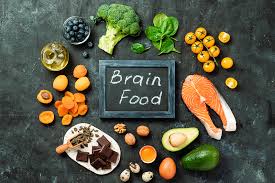In our fast-paced world, the demands on our cognitive function are relentless. We face a constant barrage of information, digital distractions, and the pressures of daily life. Many people report a persistent feeling of “brain fog,” a lack of mental clarity, or the frustrating experience of forgetting simple things like names or where they left their keys. In fact, “brain rot,” a term describing a perceived cognitive decline from excessive, low-quality online content, even became a trending topic in 2024.
This has sparked a massive interest in cognitive enhancement and neuroprotection. We are all looking for a way to sharpen our minds, improve our focus, and protect our brains for the long haul. While the market is flooded with supplements and brain-training apps, the most powerful and accessible tool for optimizing your brain is sitting right on your plate.
The food you eat directly influences the structure and function of your brain. Think of it as a high-performance vehicle: you cannot expect it to run on low-grade fuel. Your brain, an organ that consumes about 20% of your body’s total energy, requires a constant supply of premium nutrients to manage everything from your thoughts and memories to your mood and focus.
This article is your definitive guide to the world of natural nootropics. Nootropics are substances that can help improve cognitive functions like memory, creativity, and motivation. We will move beyond the hype and dive into the science-backed foods that act as powerful cognitive enhancers. We will also explore the critical connection between your stomach and your mind, known as the gut-brain axis, and how a strategic diet can build a more resilient, sharper, and healthier brain for decades to come.
The New Science of Brain Health: Why Food is the Ultimate Cognitive Enhancer
Before we reveal the top 10 list, it is essential to understand why food has such a profound impact on your mental performance. Your brain is not a static organ; it is incredibly dynamic, constantly building new connections and repairing itself. The nutrients you consume are the raw materials for this entire process.
Fueling the 20%: Your Brain’s Energy Demands
As mentioned, your brain is an energy-hungry organ. This energy is primarily derived from glucose (sugar), which your brain gets from the carbohydrates you eat. However, the type of carbohydrate matters immensely. A sugary donut provides a quick, chaotic spike in glucose, leading to an inevitable crash that leaves you feeling foggy and irritable. In contrast, complex carbohydrates, like those in whole grains and vegetables, provide a slow, steady release of glucose, ensuring your brain has a stable energy supply for sustained focus and mental stamina.
Fighting Oxidative Stress: The Role of Antioxidants and Anti-Inflammation
Your brain’s high metabolic activity generates a significant amount of byproducts called free radicals. These are unstable molecules that can damage cells, including your precious neurons. This damage is known as oxidative stress, and it is a primary driver of age-related cognitive decline and neurodegenerative diseases.
This is where antioxidants come in. These powerful compounds, found in foods like berries, dark chocolate, and leafy greens, act like a clean-up crew. They neutralize free radicals, protecting your brain cells from damage.
Similarly, chronic inflammation is another silent enemy of brain health. It can disrupt signaling between brain cells and has been linked to everything from depression to Alzheimer’s disease. Many of the foods on our list are potent anti-inflammatories that help quiet this damaging response, creating a healthier environment for your brain to thrive.
The Gut-Brain Axis: Why Your Stomach Is Your “Second Brain”
One of the most exciting and trending fields in neuroscience is the study of the gut-brain axis. This refers to the constant, two-way communication link between your gastrointestinal tract and your brain. Your gut is home to trillions of bacteria, collectively known as your microbiome.
This microbiome is not just a passive bystander in digestion. It actively produces hundreds of neurochemicals that your brain uses to regulate mood, learning, and memory. For instance, a significant portion of your body’s serotonin (the “happy” neurotransmitter) is produced in your gut.
Emerging research shows that a healthy, diverse microbiome, fed by fiber-rich foods, can improve mood, reduce anxiety, and protect against cognitive decline. Conversely, a diet high in processed foods and sugar can disrupt this delicate ecosystem, leading to inflammation and negatively impacting your brain function and mental health. When you eat to support your gut, you are directly eating to support your mind.
The Top 10 Brain-Boosting Foods for Peak Mental Performance
Here are the 10 foods you should incorporate into your diet to build a better brain, backed by strong scientific evidence.
1. Oily Fish (Salmon, Mackerel, Sardines)
The Science: Oily, cold-water fish are the number one source of the omega-3 fatty acids DHA (docosahexaenoic acid) and EPA (eicosapentaenoic acid). This is not just a minor nutrient; your brain is composed of nearly 60% fat, and a large portion of that fat is DHA.
The Benefit: DHA is absolutely essential for the structure of your brain. It is a primary building block of your brain cell membranes (neurons). Having sufficient DHA levels ensures your cell membranes are flexible and healthy, which is critical for sending and receiving signals. Studies link higher omega-3 intake to improved memory, better learning, and enhanced cognitive well-being. These fatty acids are also powerfully anti-inflammatory, protecting the brain from age-related damage.
How to Eat It: Aim for at least two servings of oily fish per week. A serving is about 3-4 ounces. Opt for wild-caught salmon when possible, as it often has a better fatty acid profile. Mackerel, herring, and sardines are also fantastic, cost-effective options. For non-fish eaters, algae-based DHA supplements are a viable alternative.
2. Blueberries (The “Potent” Brain Berries)
The Science: These small berries are one of the most powerful antioxidant-rich foods on the planet. Their deep blue and purple color comes from compounds called anthocyanins, which are a type of flavanol.
The Benefit: The antioxidants in blueberries have been shown to accumulate in the brain and help improve communication between brain cells. They do this by fighting oxidative stress and reducing inflammation. Research, including studies on the MIND diet, specifically singles out berries (especially blueberries) as a potent food for slowing cognitive decline and reducing the risk of Alzheimer’s. They have been shown to improve memory and task-switching performance in both children and older adults.
How to Eat It: The great news is that both fresh and frozen blueberries are nutritionally potent. Add a cup to your morning oatmeal or smoothie, mix them into yogurt, or simply eat them by the handful as a snack.
3. Turmeric (with Black Pepper)
The Science: This golden spice contains an active compound called curcumin. Curcumin is one of the most powerful natural anti-inflammatories known to man. Its benefits for brain health are a major focus of modern research.
The Benefit: Curcumin has been shown to cross the blood-brain barrier, meaning it can directly enter the brain and benefit the cells there. Research suggests it may help clear amyloid plaques, which are a hallmark of Alzheimer’s disease. Its anti-inflammatory properties are also linked to boosting serotonin and dopamine, which may help improve mood and fight symptoms of depression.
How to Eat It: There is one crucial catch: curcumin is very poorly absorbed by the body. However, a compound in black pepper called piperine can increase its bioavailability by as much as 2,000%. Always combine turmeric with a pinch of black pepper. Add this combination to curries, soups, scrambled eggs, or a “golden milk” latte.
4. Broccoli (and Leafy Greens like Kale & Spinach)
The Science: Broccoli and other cruciferous vegetables (like cauliflower and Brussels sprouts) are nutritional powerhouses. Broccoli is packed with Vitamin K and a compound called glucosinolate. Dark leafy greens like spinach and kale are also rich in Vitamin K, as well as folate and beta-carotene.
The Benefit: Vitamin K is a fat-soluble vitamin that is essential for forming sphingolipids, a type of fat that is densely packed into brain cells. Higher Vitamin K intake is linked to better memory and cognitive health. The glucosinolates in broccoli break down into compounds that help reduce oxidative stress and lower the risk of neurodegenerative diseases. Leafy greens are a cornerstone of the MIND diet for their proven ability to “slow cognitive decline.”
How to Eat It: Lightly steam or roast broccoli to preserve its nutrients; overcooking can destroy them. Aim for at least one serving of a dark leafy green every single day, as recommended by the MIND diet. Use kale or spinach as the base for a large lunch salad.
5. Walnuts (and other Nuts/Seeds)
The Science: Nuts are full of healthy fats, antioxidants, and Vitamin E. Walnuts are uniquely beneficial because they are also a rich source of a plant-based omega-3 fatty acid called ALA (alpha-linolenic acid), which the body can convert into DHA and EPA.
The Benefit: Vitamin E is a potent antioxidant that protects cell membranes from free radical damage, a process that is key to preventing cognitive decline. Multiple large-scale studies have linked regular nut consumption to a lower risk of dementia. Walnuts, in particular, have been shown to improve memory and cognitive test scores. Pumpkin seeds are also fantastic, providing zinc, magnesium, and copper, which are all critical for healthy brain signaling.
How to Eat It: Just a handful of nuts (about one ounce) per day is all you need. Walnuts are a great addition to salads or oatmeal. Almonds and sunflower seeds are other excellent sources of Vitamin E.
6. Dark Chocolate (70% Cacao or Higher)
The Science: This is a treat you can feel good about. Dark chocolate and cocoa powder are loaded with cacao flavonoids, antioxidants, and a small amount of caffeine.
The Benefit: The flavonoids in dark chocolate are true brain-boosters. They gather in areas of the brain that are involved in learning and memory. Research has shown they can improve blood flow to the brain, which supports overall brain function. They also help reduce stress and improve mood by boosting neurotransmitters like dopamine.
How to Eat It: This is not an excuse to eat a sugary candy bar. The benefits are in the cacao, so you must choose dark chocolate with at least 70% cacao content or higher. The higher the percentage, the greater the brain benefit (and the lower the sugar). A small square (about 1 ounce) is a perfect daily portion.
7. Eggs (The Choline Powerhouse)
The Science: Eggs are a fantastic and affordable source of several key brain nutrients, including B vitamins (B6, B12, and Folate) and, most importantly, choline.
The Benefit: Your body uses choline to create acetylcholine, a critical neurotransmitter that is essential for regulating mood and, crucially, for memory, learning, and focus. Many people are deficient in this vital nutrient. The B vitamins found in eggs also play a key role in brain health by helping to lower levels of homocysteine, an amino acid that can be toxic to brain cells and is linked to cognitive decline and Alzheimer’s.
How to Eat It: Eat the whole egg. The choline is concentrated almost entirely in the yolk. Pasture-raised eggs often contain an even better nutrient profile, including more omega-3s.
8. Green Tea (The Calm Focus Drink)
The Science: While many people turn to coffee, green tea offers a unique cognitive advantage due to its two primary compounds: L-theanine and caffeine.
The Benefit: Caffeine, as we know, provides focus and alertness. L-theanine, an amino acid found almost exclusively in tea, provides a non-drowsy “calm” by increasing alpha brain waves. The combination of L-theanine and caffeine is synergistic. It gives you the “alertness” of caffeine without the jittery, anxious side effects. Studies show this combination significantly improves accuracy, focus, and performance on demanding cognitive tasks. Green tea is also packed with antioxidants called EGCG that protect the brain.
How to Eat It: Swap your second or third cup of coffee for a cup of freshly brewed green tea. This allows you to maintain focus and energy in the afternoon without disrupting your sleep.
9. Avocados (The Healthy Fat Source)
The Science: Avocados are a fruit packed with monounsaturated fats. These are the same “good fats” found in olive oil.
The Benefit: These healthy fats are fantastic for your brain, but in a slightly different way. They support brain health by helping to reduce high blood pressure. High blood pressure (hypertension) is a major risk factor for cognitive decline and stroke. By promoting healthy blood flow, the fats in avocados help ensure your brain gets the oxygen and nutrients it needs to function at its best.
How to Eat It: Add a quarter or half an avocado to your morning toast, blend it into a smoothie for a creamy texture, or add it to your lunch salad.
10. Whole Grains (Brown Rice, Quinoa, Oats)
The Science: Your brain runs on glucose. Whole grains (like 100% whole wheat, oats, quinoa, and brown rice) are complex carbohydrates, meaning your body breaks them down slowly. They are also a good source of Vitamin E.
The Benefit: The slow and steady release of glucose from whole grains provides a stable, reliable energy source for your brain. This is the key to maintaining focus and concentration throughout the day. It prevents the sharp spikes and crashes in blood sugar that you get from refined carbs (like white bread and pastries), which are the main cause of “brain fog” and mental lethargy.
How to Eat It: Make simple swaps. Choose 100% whole-grain bread for your sandwiches, start your day with oatmeal (steel-cut or rolled, not instant packets), and swap white rice for quinoa or brown rice at dinner.
Beyond the List: The MIND Diet for Long-Term Neuroprotection
While adding these 10 foods is a fantastic start, the most significant, long-term brain protection comes from a consistent, overall eating pattern. The most celebrated of these is the MIND diet.
MIND stands for “Mediterranean-DASH Intervention for Neurodegenerative Delay.” It is a hybrid of the famously heart-healthy Mediterranean diet and the DASH diet (designed to stop hypertension). The MIND diet was developed specifically to “slow cognitive decline” and “lower the risk for dementia” and Alzheimer’s disease.
The research is stunning: studies have shown that people who follow the MIND diet closely can lower their risk of Alzheimer’s by as much as 53%. Even moderate adherence shows a significant protective benefit.
The 10 Brain-Healthy Food Groups to Eat
The MIND diet is built around these 10 food groups:
- Leafy Green Vegetables: (Kale, spinach, collards). At least 6 servings per week.
- All Other Vegetables: At least 1 serving per day.
- Berries: (Especially blueberries). At least 2 servings per week.
- Nuts: At least 5 servings per week.
- Olive Oil: Use as your primary cooking oil.
- Whole Grains: At least 3 servings per day.
- Fish: (Especially oily fish). At least 1 serving per week.
- Beans: (Lentils, soybeans, etc.). At least 4 servings per week.
- Poultry: (Chicken or turkey, non-fried). At least 2 servings per week.
- Wine: (Optional). No more than one glass per day.
The 5 Food Groups to Limit
Just as important as what you add is what you limit. The MIND diet restricts these five food groups that are known to be detrimental to brain health:
- Red Meats: Less than 3 servings per week.
- Butter and Stick Margarine: Less than 1 tablespoon per day (use olive oil instead).
- Cheese: Less than 1 serving per week.
- Pastries and Sweets: Less than 4 servings per week.
- Fried or Fast Food: Less than 1 serving per week.
Daily Information: Your Actionable Brain-Boosted Meal Plan
Knowing what to eat is one thing; putting it into practice is another. Here is a sample day of eating that incorporates many of the principles and foods we have discussed.
- Breakfast (7:00 AM):
- One bowl of steel-cut oatmeal (whole grain) topped with a cup of blueberries and a handful of walnuts.
- On the side: Two eggs, scrambled with turmeric and black pepper.
- Lunch (12:00 PM):
- The “MIND Diet Salad”: A large base of spinach and kale (leafy greens) topped with grilled salmon (oily fish), chickpeas (beans), and sliced avocado.
- Dressing: A simple vinaigrette made with olive oil.
- Afternoon Snack (3:00 PM):
- One cup of green tea for calm focus.
- A small square of 70% dark chocolate.
- Dinner (6:30 PM):
- A “Brain Bowl”: A base of quinoa (whole grain) topped with roasted broccoli, black beans, and turmeric-spiced chicken (poultry).
Conclusion: Your Brain’s Future Starts on Your Plate
Your brain is your most valuable asset. Protecting it is not about a single “miracle” food or expensive supplement. It is about making small, consistent, and intelligent choices every single day.
The foods you eat are not just calories; they are information. They provide the building blocks for your brain cells, the fuel for your thoughts, and the protection against the inflammation and oxidative stress that threaten your long-term cognitive health.
By focusing on whole, nutrient-dense foods like oily fish, berries, leafy greens, and nuts, you are engaging in the most powerful form of cognitive enhancement available. By embracing an eating pattern like the MIND diet, you are building a fortress of neuroprotection that can last a lifetime.
Your journey to a sharper, more resilient, and healthier brain does not start in a lab or a pharmacy. It starts at your next meal.
What is the one change you will make this week to start feeding your brain? Share your plan in the comments below.
Source Links and Further Reading
MedicalNewsToday: 12 Foods to Boost Brain Function(https://www.medicalnewstoday.com/articles/324044)
Rush University Medical Center: Diet May Help Prevent Alzheimer’s (on the MIND diet)(https://www.rush.edu/news/diet-may-help-prevent-alzheimers)
National Institute on Aging (NIA): What Do We Know About Diet and Prevention of Alzheimer’s Disease?(https://www.nia.nih.gov/health/alzheimers-and-dementia/what-do-we-know-about-diet-and-prevention-alzheimers-disease)
TIME Magazine: Your Gut Could Be Affecting Your Mood (on the Gut-Brain Axis)(https://time.com/7329016/gut-health-foods-brain-mood/)
National Institutes of Health (NIH): Effects of Omega-3 Polyunsaturated Fatty Acids on Brain Functions: A Systematic Review(https://pmc.ncbi.nlm.nih.gov/articles/PMC9641984/)
iHerb Blog: 3 Impressive Brain Health Benefits of Turmeric (on Curcumin and absorption)(https://www.iherb.com/blog/curcumin-brain-health/1521)
PubMed: The combined effects of L-theanine and caffeine on cognitive performance and mood(https://pubmed.ncbi.nlm.nih.gov/18681988/)
The Nut Market: 7 Nootropic Foods to Power Up Your Brain(https://thenutmarket.com.au/blogs/health-benefits/nootropic-foods)
National Institutes of Health (NIH): Demystifying the New Dilemma of Brain Rot in the Digital Era(https://pmc.ncbi.nlm.nih.gov/articles/PMC11939997/)








